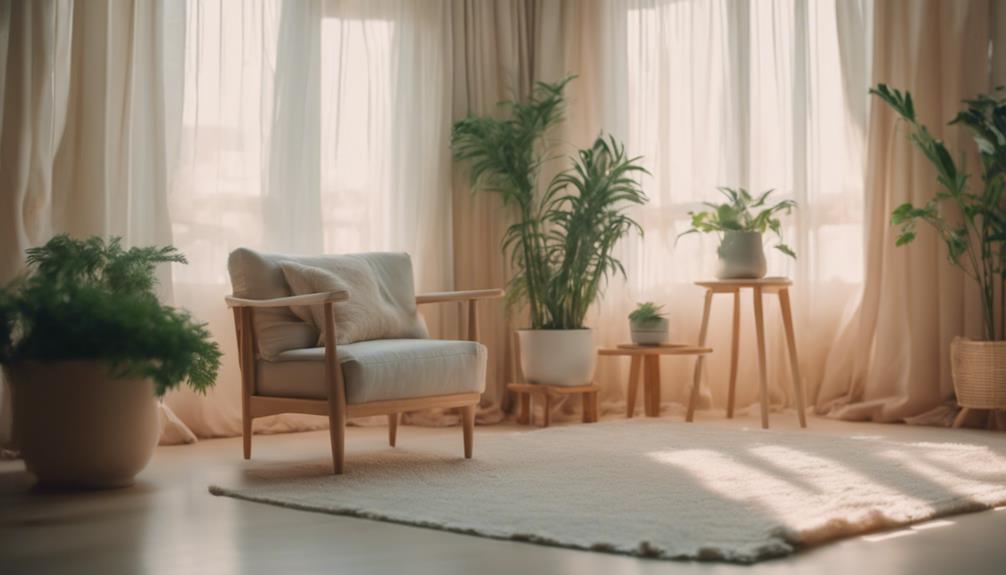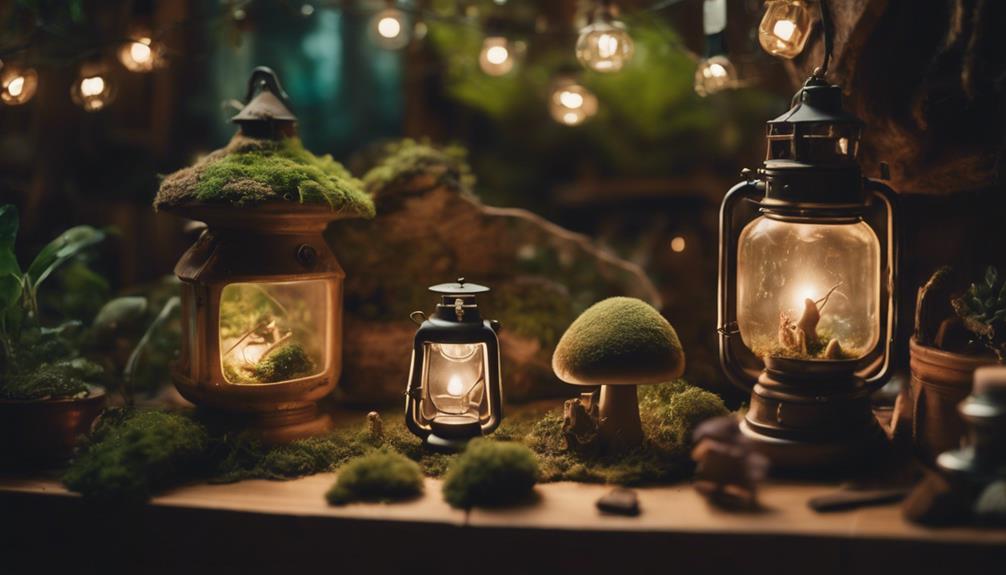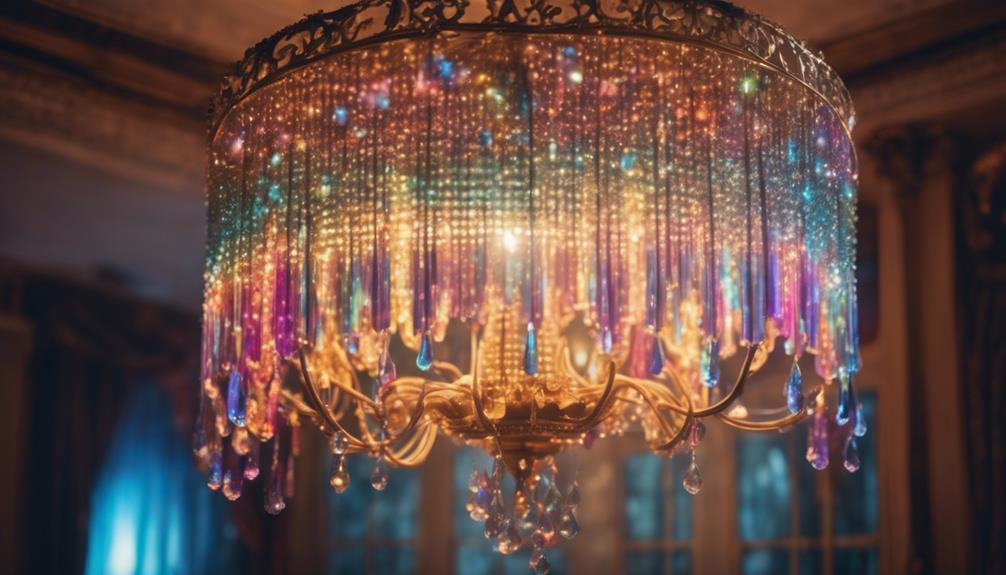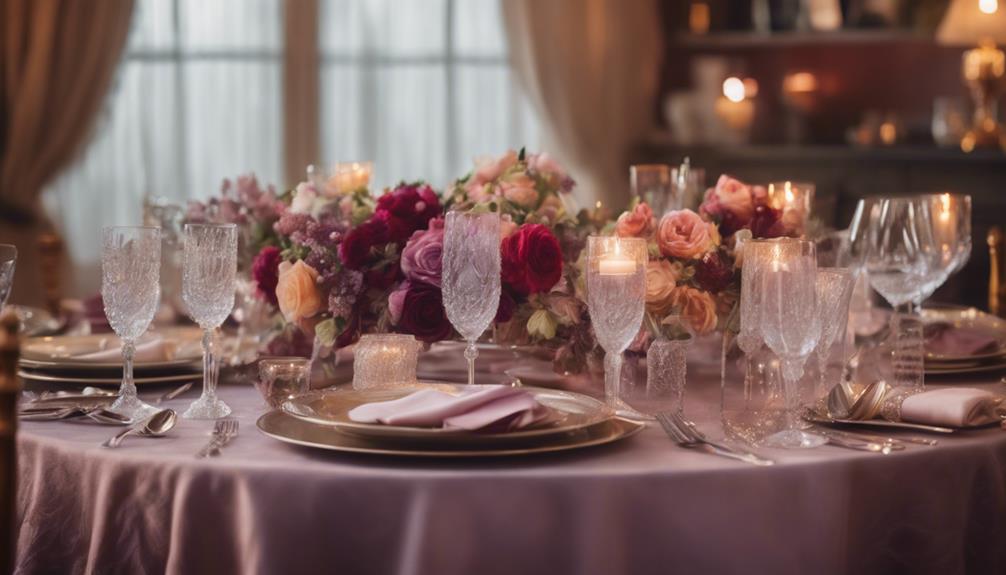You can create a peaceful room that amazes everyone by focusing on calming colors and natural materials. Use soft blues, greens, and muted neutrals to enhance relaxation. Plush textiles like cozy rugs and velvety armchairs add comfort while warm lighting sets the right mood. Integrate unique pieces like a natural wood coffee table or a hammock chair for a touch of relaxation. Don't forget decorative elements, such as botanical art and woven hangings, which bring in tranquility. With these tips, your serene space will invite calmness and emotional well-being. Discover more ideas to elevate your decor effortlessly!
Key Elements

When creating a serene space, the right color scheme, materials, and textures play an essential role.
You'll want to choose calming colors that soothe the eye and select materials that invite comfort.
Color Scheme
A calming color scheme often combines soft blues and greens to create a tranquil atmosphere that enhances relaxation in your space. These hues, associated with nature, bring a sense of serenity, making them perfect for a peaceful room.
You might also consider incorporating muted neutral tones like pale tan and soft whites, which serve as a subtle backdrop, promoting a calming effect without feeling sterile.
Don't shy away from warm shades like peach and terracotta, either. These colors can foster a cozy environment that encourages emotional well-being, making your space feel inviting.
Additionally, experimenting with less saturated colors can create an earthy feel, supporting a soothing ambiance throughout the room.
To further enhance your decor, think about biophilic design by integrating natural hues and textures. This approach not only elevates the aesthetic appeal but also contributes positively to your mental health and relaxation.
Materials
Incorporating soft textiles and natural materials is essential for creating a serene space that invites relaxation and comfort. Plush rugs, cozy throws, and soft cushions enhance warmth, making your room feel inviting. When you choose these elements, you're not just adding comfort; you're crafting areas perfect for unwinding after a long day.
Natural materials like wood, bamboo, and rattan bring a calming atmosphere to your decor. They create an organic connection to nature, which can greatly reduce stress levels. These materials complement calming color palettes, such as blues, greens, and earth tones, enhancing the overall tranquility of your room.
Don't forget about the importance of soft lighting. Thoughtfully selected lamps with warm bulbs create a cozy ambiance, making your space feel even more serene. This gentle illumination helps to promote relaxation, allowing you to find peace within your environment.
Textures
Often, mixing various textures like soft cushions, plush throws, and smooth fabrics can greatly enhance the comfort and serenity of your space. By layering materials such as silk, chenille, and faux fur, you create visual depth that invites relaxation and sensory engagement. These textures not only look appealing but also feel calming against your skin, making your room a haven of tranquility.
Incorporate textiles like rugs and curtains to absorb sound, reducing noise levels and echoes that can disrupt your peaceful environment. Opting for natural materials like cotton and linen adds coziness while connecting your room to nature, reinforcing that calming atmosphere you desire.
To keep your decor fresh and cohesive, regularly swap out textiles like throw pillows and blankets. This simple act allows for seasonal updates and maintains visual interest without overwhelming your space.
Essential Fixtures and Furniture

When you're creating a serene space, the right fixtures and furniture are key.
Consider incorporating a natural wood coffee table, a plush armchair with soft fabric, and even a hammock chair for ultimate relaxation.
These pieces not only enhance comfort but also contribute to a calming atmosphere that invites you to unwind.
Natural Wood Coffee Table
A natural wood coffee table instantly becomes the focal point of your serene space, infusing warmth and texture while enhancing the calming atmosphere. The unique grain patterns and organic shapes draw the eye, creating visual interest without overwhelming your senses. When you place your table in a spot that captures natural light, it highlights the beautiful wood finish, making your room feel even more inviting.
Opting for a light-finish wood table helps maintain a neutral color palette, promoting tranquility and a sense of sanctuary. This choice not only complements your decor but also encourages a cozy environment where you can relax and unwind. Durable and practical, a natural wood coffee table withstands daily use, making it perfect for families looking to create a comfortable space.
Moreover, selecting sustainably sourced wood supports environmental efforts, allowing you to bring an element of nature indoors. In this way, your coffee table doesn't just serve as furniture; it becomes a key piece that enhances your room's overall serenity.
Plush Armchair With Soft Fabric
Embracing the comfort of a plush armchair with soft fabric invites relaxation and transforms your serene space into a personal retreat. When you choose a chair made from luxurious materials like velvet or chenille, you enhance the cozy atmosphere of your room. Look for comfortable seating options that feature a high thread count fabric, which adds to the overall luxurious feel.
Prioritize ergonomic design to support good posture, making your armchair a perfect spot for reading or unwinding after a long day. Opt for warm, muted colors in the fabric that align with your calming decor theme, ensuring that the armchair blends seamlessly into your serene environment.
To elevate the inviting nature of your space even further, layer your plush armchair with decorative throw pillows and a soft blanket. This not only adds texture but also enhances the overall warmth of the room. By thoughtfully selecting a plush armchair, you truly create a relaxing sanctuary where you can escape the chaos of everyday life.
Hammock Chair for Relaxation
Transform your space into a cozy retreat by adding a hammock chair, which invites relaxation and provides a perfect spot to unwind or immerse yourself in a good book. This essential fixture not only enhances your room's aesthetic but also promotes a peaceful environment where you can escape the chaos of everyday life.
Hammock chairs, often crafted from breathable materials like cotton or canvas, offer comfort and airflow, ensuring you feel at ease while you relax. They can be suspended from ceilings or sturdy frames, requiring minimal floor space, making them ideal for any room, regardless of size.
With a variety of styles, colors, and designs available, you can easily find a hammock chair that complements your existing decor, enhancing the serene ambiance. Adding one encourages mindfulness and relaxation practices, providing a dedicated space for meditation or quiet reflection.
Lighting Ideas

When it comes to lighting, you want to focus on creating a soothing atmosphere that complements your serene space.
Consider using soft LED strip lighting, adjustable floor lamps, and hanging pendant lights to add warmth and ambiance.
Dimmable wall sconces can also enhance the overall effect, allowing you to set the perfect mood for relaxation.
Soft LED Strip Lighting
Soft LED strip lighting adds a customizable glow to your space, enhancing the atmosphere and creating a soothing environment perfect for relaxation. You can easily install these strips along walls, ceilings, or furniture edges, providing a beautiful ambient light that transforms any room.
With a variety of colors and brightness levels, soft LED strip lighting allows you to create a calming mood that suits your needs, whether you're reading a book or meditating.
Most LED strips are dimmable and can be controlled via a remote or smartphone app, giving you the convenience to adjust the lighting effortlessly. This versatility means you can shift from bright, energizing lights to soft, gentle hues depending on your activity or time of day.
Plus, these lights are energy-efficient and long-lasting, so you won't have to worry about high electricity bills or frequent replacements.
Incorporating soft LED strip lighting in relaxation zones like reading nooks or meditation spaces can greatly enhance your unwinding experience. By choosing the right colors and brightness, you'll cultivate an inviting atmosphere that promotes tranquility and personal reflection.
Adjustable Floor Lamps for Ambiance
Adjustable floor lamps provide the flexibility to tailor your lighting to fit your mood, whether you're enjoying a quiet evening with a book or hosting friends for a lively gathering.
With versatile lighting options, these lamps enable you to customize brightness and angle, creating the perfect ambiance for relaxation. Many models feature dimming capabilities, allowing you to effortlessly switch from bright task lighting to soft, warm light, enhancing a calming atmosphere.
Some adjustable floor lamps come with multiple light sources, offering layered lighting that elevates both the aesthetic and functionality of your space. This feature is especially beneficial in creating a cozy nook for reading or unwinding after a long day.
Choosing lamps with adjustable heights lets you direct light exactly where you need it, ensuring ideal comfort.
Additionally, energy-efficient LED options not only reduce your electricity bills but also provide long-lasting illumination with minimal heat emission, keeping your environment comfortable.
Hanging Pendant Lights With Warmth
Hanging pendant lights can transform your space into a warm and inviting haven, especially with the right choice of soft bulbs that enhance relaxation. By selecting hanging pendant lights in neutral tones or warm materials like wood or brass, you can create a calming atmosphere that complements your serene decor.
Consider using adjustable pendant lights, which let you customize brightness and direction. This flexibility helps set the perfect mood, whether you're unwinding after a long day or hosting friends. Clustered pendant lights can also add visual interest while drawing the eye upward, making your room feel more spacious and intimate at the same time.
When choosing designs, think about styles that resonate with your personal aesthetic. Whether you prefer sleek modern lines or rustic charm, the right hanging pendant lights can serve as a stunning focal point in your room.
Pair these lights with soft, warm bulbs to enhance the overall ambiance, ensuring your space feels both welcoming and relaxing. With thoughtful placement and design, hanging pendant lights can truly elevate your serene space, making it a place where you and your guests will feel at ease.
Dimmable Wall Sconces for Warmth
Dimmable wall sconces bring versatile lighting options that allow you to easily create a warm and inviting atmosphere tailored to your mood. With adjustable brightness, you can seamlessly shift from bright task lighting for reading or working to softer ambient lighting for relaxation and unwinding. This flexibility makes dimmable wall sconces essential for a calming environment.
Available in various styles and finishes, these sconces not only enhance your room's decor but also provide functional lighting that suits your needs. You can choose designs that complement your aesthetic, whether modern, rustic, or anything in between.
For added convenience, consider pairing your dimmable sconces with smart home technology. This lets you control the brightness effortlessly using smartphone apps or voice commands.
Incorporating dimmable wall sconces into your decor can notably improve the overall aesthetic and functionality of your space. By creating a calming atmosphere, you invite relaxation and serenity into your daily life.
As you adjust the lighting to fit different moments, your room transforms into a peaceful retreat that everyone will admire. So, explore the options and elevate your space with these stylish and practical lighting solutions!
Decorative Elements
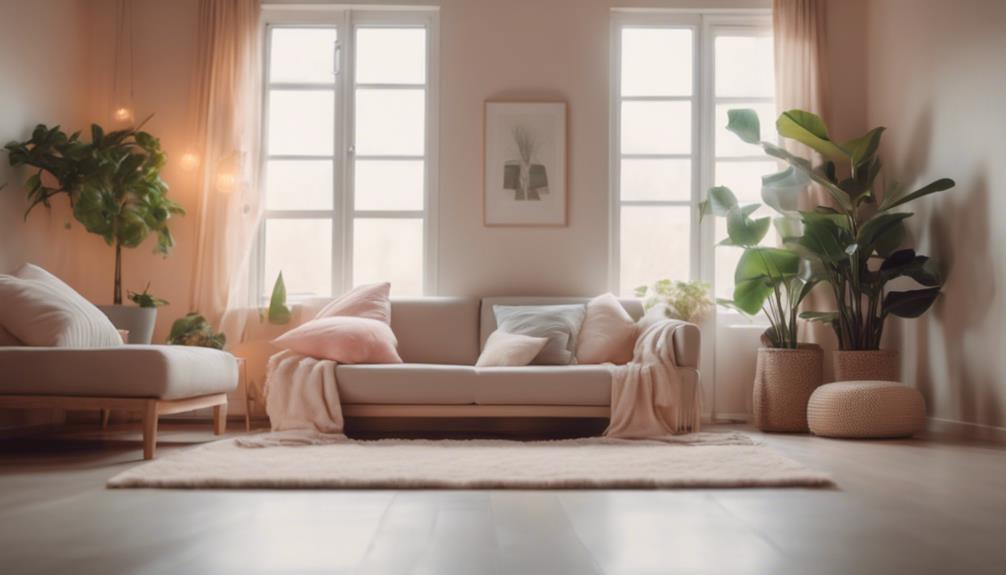
To create a serene space, you can incorporate decorative elements that reflect your style and enhance tranquility.
Handcrafted ceramic vases, framed botanical wall art, and woven wall hangings not only add visual interest but also foster a calming atmosphere.
Handcrafted Ceramic Vase
Handcrafted ceramic vases offer a unique blend of artistry and functionality, enhancing your space with their distinct character and earthy tones. These ceramic vases not only showcase the artisan's skill but also provide a personal touch that elevates your decor. Their natural textures and calming colors complement neutral palettes, contributing to a serene atmosphere that invites relaxation.
When you incorporate a variety of sizes and shapes in your ceramic vases, you create visual interest and depth. This draws the eye, enhancing the overall aesthetic appeal of your room. Whether you fill them with fresh blooms, dried arrangements, or leave them empty as sculptural pieces, these vases serve as versatile decorative elements that suit any style.
Moreover, many handcrafted ceramic vases are made using sustainable practices, making them an eco-friendly choice. By choosing these pieces, you align your decor with a thoughtful and conscious approach to design.
Framed Botanical Wall Art
Framed botanical wall art effortlessly brings the beauty of nature indoors, creating a serene atmosphere that promotes relaxation. By incorporating various sizes of botanical prints, you add visual interest and depth to your walls, making your decor more engaging and inviting. Opt for artwork featuring soft, muted colors, as these hues complement a neutral color palette and contribute to an overall calming ambiance.
Displaying framed botanical prints at eye level maximizes their impact, encouraging mindfulness and providing a daily reminder of nature's beauty. This thoughtful placement not only enhances the room's aesthetic but also fosters a connection to the artwork and the tranquility it represents.
Additionally, framed botanical wall art can serve as a conversation starter that reflects your personal tastes and interests. You'll find that guests appreciate the emotional connections these pieces create, making your space feel even more welcoming.
Woven Wall Hanging
Woven wall hangings bring a unique texture and warmth to your space, enhancing the serene atmosphere established by framed botanical wall art. These decorative elements often use natural fibers like cotton, wool, or jute, which not only contribute to a calming aesthetic but also create a peaceful place where you can unwind. By adding texture to your walls, you invite a sense of coziness that promotes relaxation.
Woven wall hangings can serve as focal points in your room, drawing the eye and creating visual interest without disrupting the tranquil vibe. Whether you lean towards bohemian, minimalist, or any style in between, these versatile pieces allow for personal expression in your home decor.
Moreover, incorporating a woven wall hanging can help absorb sound, making your environment quieter and more conducive to peace. As you decorate, consider how these elements can complement other pieces in your space.
With their ability to balance style and serenity, woven wall hangings are a must-have for anyone looking to create a calming atmosphere that truly amazes everyone.
Flooring
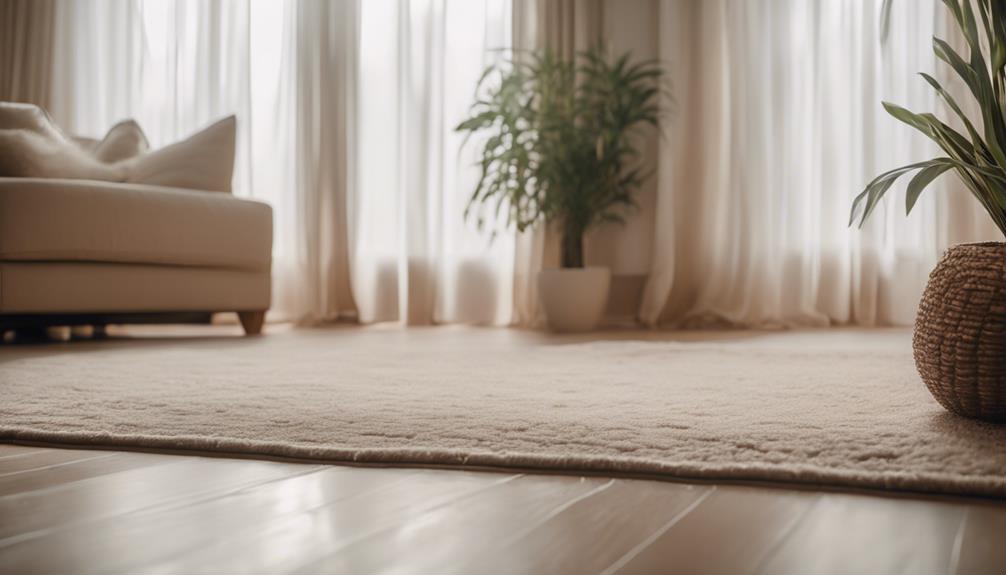
When it comes to flooring, you've got some great options that balance style and serenity.
Bamboo flooring offers sustainability, while cork provides excellent sound absorption.
Reclaimed wood adds rustic charm to your space.
Choosing the right material can considerably enhance the tranquility of your room.
Bamboo Flooring for Sustainability
Bamboo flooring stands out as a sustainable choice, thanks to its rapid growth and minimal ecological impact compared to traditional hardwoods. As a sustainable option, bamboo reaches maturity in just 3-5 years, while hardwoods can take decades to develop. This fast regeneration makes it an ideal material for those looking to create an environmentally conscious home.
In addition to being a sustainable option, bamboo flooring boasts impressive durability. With a high hardness rating, it's tough enough to withstand the wear and tear of high-traffic areas, ensuring it can handle your daily activities without looking worn.
Plus, its natural resistance to moisture and insects means you won't need chemical treatments, making it an eco-friendly choice that contributes to healthier indoor air quality.
Many bamboo products are manufactured using environmentally friendly processes, including low-VOC adhesives, which are better for both your home and the planet. Harvesting bamboo doesn't kill the plant, allowing it to continuously grow and regenerate, which further minimizes the ecological impact of flooring production.
Cork Flooring for Sound Absorption
Cork flooring provides exceptional sound absorption, helping you create a tranquil space that's free from disruptive noise. Its unique cellular structure contains millions of tiny air pockets that effectively dampen sound vibrations, reducing noise levels by up to 30% compared to harder surfaces like tile or hardwood. This makes cork an ideal choice for your room, allowing you to relax and unwind in peace.
In addition to its sound-insulating properties, cork flooring is anti-static, meaning it won't attract dust or allergens. This contributes to healthier indoor air quality, enhancing your overall relaxation experience. With various styles and colors available, cork can seamlessly blend with your calming decor, elevating the aesthetic of your serene space.
Moreover, cork is a sustainable and eco-friendly option, harvested from the bark of cork oak trees without causing harm. By choosing cork flooring, you're not only investing in a peaceful atmosphere but also making a responsible choice for the environment.
Transform your room into a soothing retreat where you can truly relax and unwind, free from the distractions of everyday life.
Reclaimed Wood for Rustic Charm
Embracing reclaimed wood flooring instantly adds rustic charm to your space, showcasing its unique character through natural variations in color and texture. This flooring option tells a story of its previous life, making it a conversation starter in your entire room. Not only does reclaimed wood bring warmth and authenticity, but it also promotes a serene atmosphere that enhances comfort and tranquility.
Choosing reclaimed wood is an environmentally friendly decision, as it repurposes materials that might otherwise contribute to waste. By reducing the demand for new lumber, you're making a positive impact on the environment. Additionally, reclaimed wood often enhances indoor air quality, as it's sourced from aged structures like old barns, avoiding the harmful chemicals found in new flooring.
Durability is another significant benefit; reclaimed wood typically comes from hardwood species that have proven their strength over time. This makes it a long-lasting investment for your home.
When you opt for reclaimed wood flooring, you're not just transforming your space; you're creating a calming oasis that will amaze everyone who steps into your room.
Conclusion
By incorporating these key elements into your space, you can transform any room into a serene sanctuary that truly amazes.
Choose essential fixtures and furniture that promote relaxation, embrace soft lighting options, and add decorative touches that reflect your personal style.
Don't forget about the flooring, as it plays a vital role in setting the mood.
With these tips, you'll create a calming environment that invites tranquility and leaves a lasting impression on everyone who enters.
